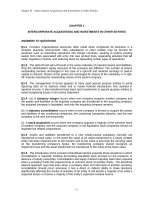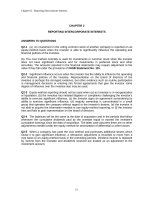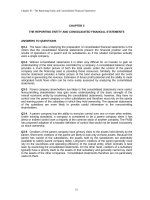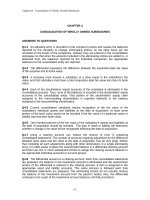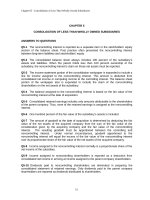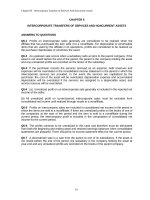Solution manual investment 12thbodie investments 12e SM CH22
Bạn đang xem bản rút gọn của tài liệu. Xem và tải ngay bản đầy đủ của tài liệu tại đây (68.69 KB, 8 trang )
CHAPTER 22: FUTURES MARKETS
CHAPTER 22: FUTURES MARKETS
PROBLEM SETS
1.
There is little hedging or speculative demand for cement futures, since cement prices
are fairly stable and predictable. The trading activity necessary to support the futures
market would not materialize. Only those commodities and financial securities with
significant volatility tend to have futures contracts available for hedgers and
speculators.
2.
The ability to buy on margin is one advantage of futures. Another is the ease with which
one can alter one’s holdings of the asset. This is especially important if one is dealing in
commodities, for which the futures market is far more liquid than the spot market.
3.
Short selling results in an immediate cash inflow, whereas the short futures
position does not:
Action
Initial CF
Short sale
Short futures
4.
a.
+P0
0
Final CF
–PT
F0 – PT
False. For any given level of the stock index, the futures price will be lower
when the dividend yield is higher. This follows from spot-futures parity:
F0 = S0 (1 + rf – d)T
b.
False. The parity relationship tells us that the futures price is determined by the
stock price, the interest rate, and the dividend yield; it is not a function of beta.
c.
True. The short futures position will profit when the S&P 500 Index falls. This is
a negative beta position.
5.
The futures price is the agreed-upon price for deferred delivery of the asset. If that
price is fair, then the value of the agreement ought to be zero; that is, the contract
will be a zero-NPV agreement for each trader. Over time, however, the price of the
underlying asset will change and this will affect the value of the contract.
6.
Because long positions equal short positions, futures trading must entail a
“canceling out” of bets on the asset. Moreover, no cash is exchanged at the
inception of futures trading. Thus, there should be minimal impact on the spot
22-1
Copyright © 2021 McGraw-Hill Education. All rights reserved. No reproduction or distribution without the prior written consent of
McGraw-Hill Education.
CHAPTER 22: FUTURES MARKETS
market for the asset, and futures trading should not be expected to reduce capital
available for other uses.
7.
a.
The closing futures price for the June contract was 2555.00, which has a
dollar value of:
$50 × 2555.00 = $127,750
Therefore, the required margin deposit is: $12,775
8.
b.
The futures price increases by: $2600.00 – 2555.00 = $45.00
The credit to your margin account would be: 45.00 × $50 = $2,250
This is a percent gain of: $2,250/$12,775 = 0.1760 = 17.60%
Note that the futures price itself increased by only 1.76%.
c.
Following the reasoning in part (b), any change in F is magnified by a ratio
of
(l /margin requirement). This is the leverage effect. The return will be –10%.
a.
F0 = S0(1 + rf ) = $150 × 1.03 = $154.50
b. F0 = S0(1 + rf )3 = $150 × 1.033 = $163.91
9.
10.
c.
F0 = 150 × 1.063 = $178.65
a.
Take a short position in T-bond futures, to offset interest rate risk. If rates
increase, the loss on the bond will be offset to some extent by gains on the
futures.
b.
Again, a short position in T-bond futures will offset the interest rate risk.
c.
You want to protect your cash outlay when the bond is purchased. If bond
prices increase, you will need extra cash to purchase the bond. Thus, you
should take a long futures position that will generate a profit if prices
increase.
a. F0 = S0 × (l + rf – d) = 2,000 × (1 + 0.03 – 0.02) = 2,020
b. If the T-bill rate is less than the dividend yield, then the futures price should be
less than the spot price.
F0 = S0 × (l + rf – d) = 2,000 × (1 + 0.01 – 0.02) = 1,980
11.
The put-call parity relation states that: But spot-futures parity tells us that:
X
C = P + S0 −
F = S0 × (1 + rf )T
(1 + rf )T
22-2
Copyright © 2021 McGraw-Hill Education. All rights reserved. No reproduction or distribution without the prior written consent of
McGraw-Hill Education.
CHAPTER 22: FUTURES MARKETS
Substituting, we find that:
P = C − S0 +
12.
[ S0 × (1 + rf )T ]
(1 + rf )T
= C − S0 + S 0 = C
According to the parity relation, the proper price for December futures is:
FDec = FJune(l + rf )1/2 = 1500 × 1.02 1/2 = 1,514.93
The actual futures price for December is low relative to the June price. You should
take a long position in the December contract and short the June contract.
13.
a.
120 × 1.06 = $127.20
b.
The stock price falls to: 120 × (1 – 0.03) = $116.40
The futures price falls to: 116.4 × 1.06 = $123.384
The investor loses: (127.20 – 123.384) × 1,000 = $3,816
14.
c.
The percentage loss is: $3,816/$12,000 = 0.318 = 31.8%
a.
The initial futures price is F0 = $2,250 × (1 + 0.005 – 0.002)12 = $2,332.35
In one month, the futures price will be:
F0 = $2,275 × (1 + 0.005 – 0.002)11 = $2,351.21
The increase in the futures price is 18.86, so the cash flow will be:
$18.86 × 50 = $943.00
b.
The holding period return is: $943.00/$5,000 = 0.1886 = 18.86%
15.
The treasurer would like to buy the bonds today but cannot. As a proxy for this
purchase, T-bond futures contracts can be purchased. If rates do in fact fall, the
treasurer will have to buy back the bonds for the sinking fund at prices higher than
the prices at which they could be purchased today. However, the gains on the
futures contracts will offset this higher cost to some extent.
16.
The parity value of F is: $2,000 × (1 + 0.04 – 0.01) = $2,060
The actual futures price is $2,050, too low by 10.
Arbitrage
Portfolio
CF
now
CF in 1 year
22-3
Copyright © 2021 McGraw-Hill Education. All rights reserved. No reproduction or distribution without the prior written consent of
McGraw-Hill Education.
CHAPTER 22: FUTURES MARKETS
Short index
Buy futures
Lend
2,000
0
−2,000
−ST − (0.01 × 2,000)
ST – 2,050
2,000× 1.04
0
10
Total
17.
a.
Futures prices are determined from the spreadsheet as follows:
Spot Futures Parity and Time Spreads
Spot price
2,000
Income yield (%)
2.0 Futures prices versus maturity
Interest rate (%)
3.0
Today's date
1/1/2016 Spot price
2,000.00
Maturity date 1
2/14/2016 Futures 1
2,002.38
Maturity date 2
5/21/2016 Futures 2
2,007.75
Maturity date 3
11/18/2016 Futures 3
2,017.60
Time to maturity 1
Time to maturity 2
Time to maturity 3
0.12
0.39
0.88
LEGEND:
Enter data
Value calculated
See comment
b.
The spreadsheet demonstrates that the futures prices now decrease with
increased income yield:
Spot price
Income yield (%)
Interest rate (%)
Today's date
Maturity date 1
Maturity date 2
Maturity date 3
Time to maturity 1
Time to maturity 2
Time to maturity 3
Spot Futures Parity and Time Spreads
2,000
4.0 Futures prices versus maturity
3.0
1/1/2016 Spot price
2,000.00
2/14/2016 Futures 1
1,997.60
5/21/2016 Futures 2
1,992.20
11/18/2016 Futures 3
1,982.38
0.12
0.39
0.88
LEGEND:
Enter data
Value calculated
See comment
22-4
Copyright © 2021 McGraw-Hill Education. All rights reserved. No reproduction or distribution without the prior written consent of
McGraw-Hill Education.
CHAPTER 22: FUTURES MARKETS
18.
a.
The current yield for Treasury bonds (coupon divided by price) plays the role of
the dividend yield.
b., c. When the yield curve is upward sloping, the current yield exceeds the short
rate. Hence, T-bond futures prices on more distant contracts are lower than those
on near-term contracts. Confirmed with Figure 22.1
19.
a.
Action
Cash Flows
T1
Now
Long futures with maturity T1
Short futures with maturity T2
Buy asset at T1, sell at T2
At T1, borrow F( T1)
0
0
0
0
P1 – F( T1)
Total
0
0
T2
0
F( T2) – P2
P2
0
–P1
F( T1)
–F( T1) × (1+ rf )
( T2–T1)
F( T2) – F( T1) × (1+ rf )
T1)
b.
Since the T2 cash flow is riskless and the net investment was zero, then any
profits represent an arbitrage opportunity.
c.
The zero-profit no-arbitrage restriction implies that
F( T2 ) = F( T1) × (1+ rf ) ( T
2
( T2–
– T1)
CFA PROBLEMS
1.
a.
The strategy that would take advantage of the arbitrage opportunity is a “reverse
cash and carry.” A reverse cash and carry opportunity results when the following
relationship does not hold true:
F0 ≥ S0 (1+ C)
If the futures price is less than the spot price plus the cost of carrying the goods to
the futures delivery date, then an arbitrage opportunity exists. A trader would be
able to sell the asset short, use the proceeds to lend at the prevailing interest rate,
and then buy the asset for future delivery. At the future delivery, the trader would
then collect the proceeds of the loan with interest, accept delivery of the asset, and
cover the short position in the commodity.
b.
Cash Flows
Action
Now
Sell the spot commodity short
+$120.00
One year from now
−
$125.00
22-5
Copyright © 2021 McGraw-Hill Education. All rights reserved. No reproduction or distribution without the prior written consent of
McGraw-Hill Education.
CHAPTER 22: FUTURES MARKETS
Buy the commodity futures expiring in 1
year
Contract to lend $120 at 8% for 1 year
Total cash flow
2.
3.
$0.00
−$120.00
$0.00
$0.00
+$129.60
+$4.60
a.
The call option is distinguished by its asymmetric payoff. If the Swiss franc
rises in value, then the company can buy francs for a given number of dollars
to service its debt and thereby put a cap on the dollar cost of its financing. If
the franc falls, the company will benefit from the change in the exchange
rate.
The futures and forward contracts have symmetric payoffs. The dollar cost of
the financing is locked in regardless of whether the franc appreciates or
depreciates. The major difference from the firm’s perspective between futures
and forwards is in the mark-to-market feature of futures. The consequence of
this is that the firm must be ready for the cash management issues surrounding
cash inflows or outflows as the currency values and futures prices fluctuate.
b.
The call option gives the company the ability to benefit from depreciation in the
franc but at a cost equal to the option premium. Unless the firm has some
special expertise in currency speculation, it seems that the futures or forward
strategy, which locks in a dollar cost of financing without an option premium,
may be the better strategy.
The important distinction between a futures contract and an options contract is that the
futures contract is an obligation. When an investor purchases or sells a futures
contract, the investor has an obligation to either accept or deliver, respectively, the
underlying commodity on the expiration date. In contrast, the buyer of an option
contract is not obligated to accept or deliver the underlying commodity but instead has
the right, or choice, to accept delivery (for call holders) or make delivery (for put
holders) of the underlying commodity anytime during the life of the contract.
Futures and options modify a portfolio’s risk in different ways. Buying or selling a
futures contract affects a portfolio’s upside risk and downside risk by a similar
magnitude. This is commonly referred to as symmetrical impact. On the other hand,
the addition of a call or put option to a portfolio does not affect a portfolio’s upside
risk and downside risk to a similar magnitude. Unlike futures contracts, the impact of
options on the risk profile of a portfolio is asymmetric.
4.
a.
The investor should sell the forward contract to protect the value of the bond
against rising interest rates during the holding period. Because the investor
intends to take a long position in the underlying asset, the hedge requires a short
position in the derivative instrument.
22-6
Copyright © 2021 McGraw-Hill Education. All rights reserved. No reproduction or distribution without the prior written consent of
McGraw-Hill Education.
CHAPTER 22: FUTURES MARKETS
b.
The value of the forward contract on expiration date is equal to the spot price of
the underlying asset on expiration date minus the forward price of the contract:
$978.40 – $1,024.70 = –$46.30
The contract has a negative value. This is the value to the holder of a long
position in the forward contract. In this example, the investor should be short the
forward contract, so that the value to this investor would be +$46.30 since this is
the cash flow the investor expects to receive.
c.
The value of the combined portfolio at the end of the six-month holding period is:
$978.40 + $46.30 = $1,024.70
The change in the value of the combined portfolio during this six-month
period is $24.70
The value of the combined portfolio is the sum of the market value of the
bond and the value of the short position in the forward contract. At the start
of the six-month holding period, the bond is worth $1,000 and the forward
contract has a value of zero (because this is not an off-market forward
contract, no money changes hands at initiation). Six months later, the bond
value is $978.40 and the value of the short position in the forward contract
is $46.30, as calculated in part (b).
The fact that the combined value of the long position in the bond and the
short position in the forward contract at the forward contract’s maturity date
is equal to the forward price on the forward contract at its initiation date is
not a coincidence. By taking a long position in the underlying asset and a
short position in the forward contract, the investor has created a fully hedged
(and hence risk-free) position and should earn the risk-free rate of return. The
six-month risk-free rate of return is 5% (annualized), which produces a
return of $24.70 over a six-month period:
($1,000 × 1.05(1/2)) – $1,000 = $24.70
These results support VanHusen’s statement that selling a forward contract on
the underlying bond protects the portfolio during a period of rising interest
rates. The loss in the value of the underlying bond during the six-month holding
period is offset by the cash payment made at expiration date to the holder of the
short position in the forward contract; that is, a short position in the forward
contract protects (hedges) the long position in the underlying asset.
5.
a.
Accurate. Futures contracts are marked to the market daily. Holding a short
position on a bond futures contract during a period of rising interest rates
(declining bond prices) generates positive cash inflow from the daily mark to
market. If an investor in a futures contract has a long position when the price of
the underlying asset increases, then the daily mark to market generates a
positive cash inflow that can be reinvested. Forward contracts settle only at
expiration date and do not generate any cash flow prior to expiration.
22-7
Copyright © 2021 McGraw-Hill Education. All rights reserved. No reproduction or distribution without the prior written consent of
McGraw-Hill Education.
CHAPTER 22: FUTURES MARKETS
b.
Inaccurate. According to the cost-of-carry model, the futures contract price is
adjusted upward by the cost of carry for the underlying asset. Bonds (and other
financial instruments), however, do not have any significant storage costs.
Moreover, the cost of carry is reduced by any coupon payments paid to the
bondholder during the life of the futures contract. Any “convenience yield”
from holding the underlying bond also reduces the cost of carry. As a result, the
cost of carry for a bond is likely to be negative.
22-8
Copyright © 2021 McGraw-Hill Education. All rights reserved. No reproduction or distribution without the prior written consent of
McGraw-Hill Education.




